THE VIRUS TAKES A WOMAN MARINE (1918)
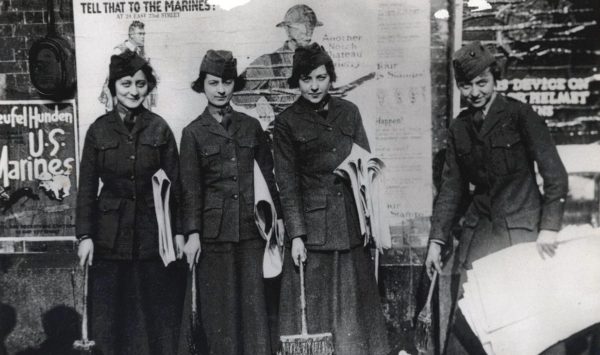
******************************************************************************************************************************** Brownstone Detectives investigates the history of our clients’ homes. The story you are about to read was composed from research conducted in the course of one of those investigations. Do you know the history of YOUR house? ******************************************************************************************************************************** In 2014, The Brownstone Detectives partnered with the New York City Parks Department to help celebrate the lives of the servicemembers of Bedford-Stuyvesant Heights who made the ultimate sacrifice during the Great War. We researched these heroes to locate pictures, stories, and their descendants to be brought together for a ceremony that dedicated a new “Victory and Peace” war memorial at Saratoga Park. This biography tells the story of one of those servicemembers. PROLOGUE In 1918, when the United States was fighting a war overseas, the country was also fighting a conflict back home – influenza. Just as people were dying in the the “Great War” to combat “the Hun,” Americans were succumbing back home to a virus that was leading to their deaths in hospitals. Much like with today’s coronavirus, there were still essential services then that needed to be continued. One of those services was recruiting for that overseas war. One of those recruiters was one of the first woman Marines. She lived on Macon Street in the Bedford-Stuyvesant section of Brooklyn. She came down with influenza while on recruiting duty in Manhattan. And she became the first woman Marine buried with full military honors. This is her story. PVT. LILLIAN MAY BOGEN PATTERSON It would be a mistake […]
WHEN SARATOGA AVENUE WAS YOUNG (1899)
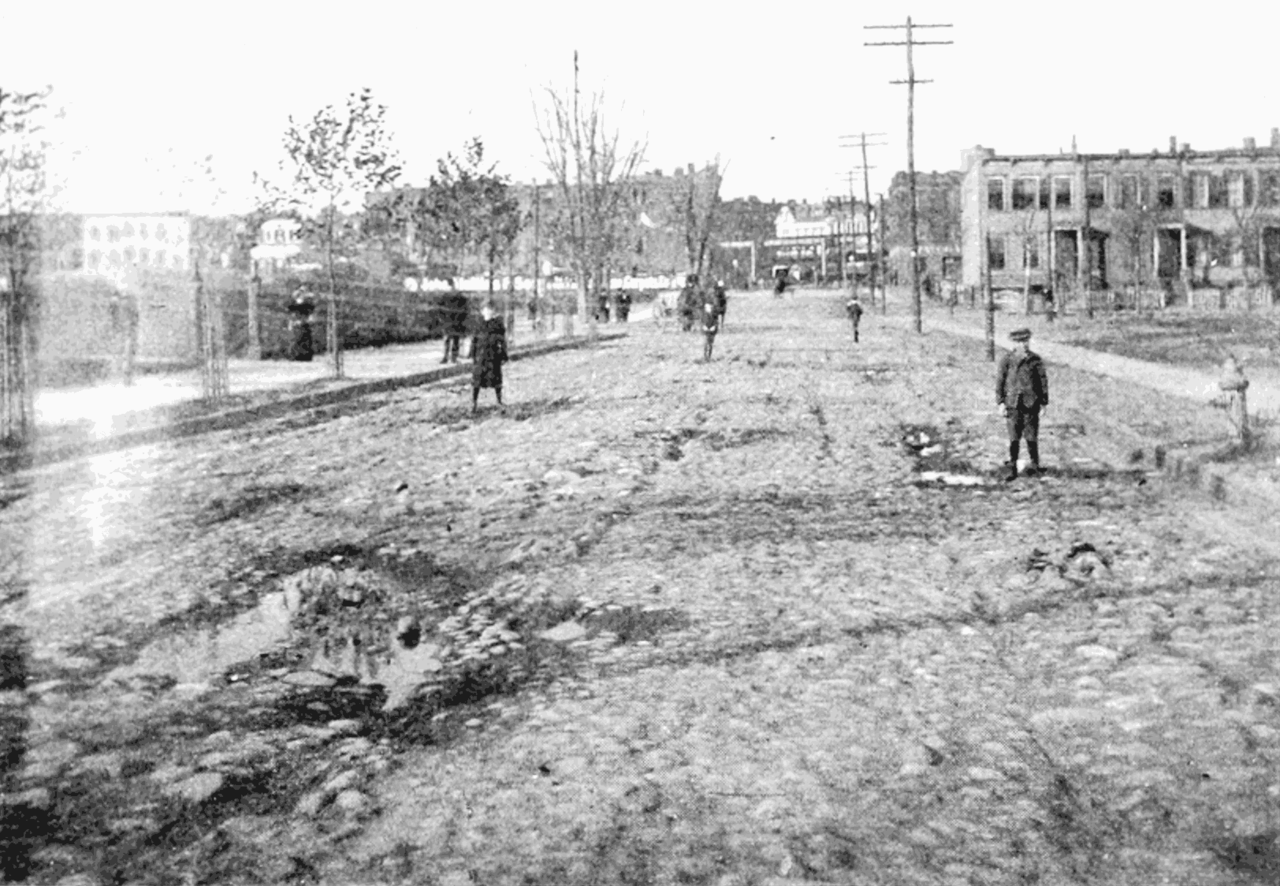
******************************************************************************************************************************** Brownstone Detectives investigates the history of our clients’ homes. The story you are about to read was composed from research conducted in the course of one of those investigations. Do you know the history of YOUR house? ******************************************************************************************************************************** We’d never seen this 1899 picture before – the cobblestones of Saratoga Avenue – taken from Macon Street looking north. To the left you see the gates of the 3-year old Saratoga Square Park and to the right, what was known then as Saratoga Field. A few years before this shot was taken, you would have seen the circus and the various Wild West shows of the time camping out on these two blocks, attracting crowds of people from miles around to the neighborhood. In the distance, you can see the elevated Brooklyn Rapid Transit track, known around this time as the Broadway Elevated, which had opened in 1893 and was a 2-track line at the time. That’s right – no express! And staring back at you are some of the folks who lived and played in the area. It appears from the shot that they were positioned by the photographer. They’re all standing still and upright. Across the street from the park (on the right side of the photograph) would soon be built the Arcadia Dancehall, a “modern dancehall for working girls,” where the modern dances of the day – such as the Bunny Hug and the Tango – were forbidden. Vice President Calvin Coolidge and Teddy Roosevelt’s son, Theodore, […]
RISE & FALL OF THE STUYVESANT CLOWN (1895)
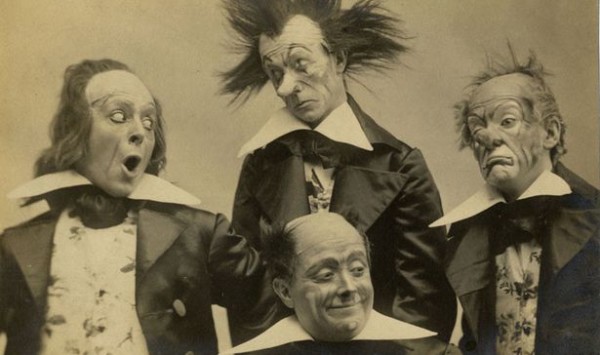
******************************************************************************************************************************* Brownstone Detectives investigates the history of our clients’ homes. The story you are about to read was composed from research conducted in the course of one of those investigations. Do you know the history of YOUR house? ******************************************************************************************************************************* Back in the early 1890s, in Stuyvesant Heights, there were clowns everywhere. Roaming and squeezing their little horns, making sad, droopy faces, and generally miming mischief. And everyone came to see them at Halsey Street and Saratoga where they paid a nickel a person to get in. Life for the clowns existed there for at least 20 years, until one day it all came to a halt. The developers had arrived and were threatening the home of the clown, threatening his very existence. BROOKLYN EXPANDS TO BUSHWICK By the mid-1890s, three blocks in the furthest reaches of the Eastern District’s Stuyvesant Heights had surprisingly remained untouched by speculative progress. While feverish land purchasing and selling had gone on all around this valuable real estate for the previous ten or so years, these dusty plots of land would continue to sit like the vestiges of the past that they were – unused farm land. Eventually, though, this land would be put to use by a bunch of clowns – the lots would begin, in 1891, to be referred to as the “circus grounds,” as traveling circuses and shows would begin annually to rent the land for their high profile extravaganzas. But the reign of the Stuyvesant Clown would be relatively short as, […]
THE EFFECTS OF WAR ON BED-STUY (1918)
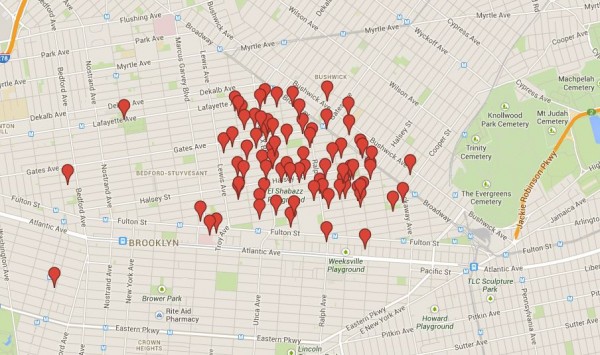
******************************************************************************************************************************** Brownstone Detectives investigates the history of our clients’ homes. The story you are about to read was composed from research conducted in the course of one of those investigations. Do you know the history of YOUR house? ******************************************************************************************************************************** During the brief period that the U.S. was engaged in WWI, the eastern section of Brooklyn’s Stuyvesant Heights section was decimated by its contribution of men to the war effort. Then, it was decimated a second time by the generous contribution it made of many of these mens’ lives. According to the honor rolls of the “Victory & Peace” memorial in Saratoga Park, approximately 105 men (and one woman) from the neighborhood made the ultimate sacrifice. There was a death on nearly every block of the district – often more. The MAP above shows with red pins the locations where some of these men lived – many of them who had left new wives, parents, and families waiting for them back home. The servicemembers, represented on this map by these red dots, never made it back home, though. Most were buried in American Cemeteries in France; some were re-buried here in the U.S. After the war, the Gold Star Mothers pilgrimages began to take place, as thousands of the mothers of these servicemembers made the government-sponsored trips to France in order to visit the last resting places of their children. Today, the specific memories of these citizens who grew up together, went to school together, played, learned, and competed together here […]
THE GREAT BROOKLYN FLOOD OF 1903
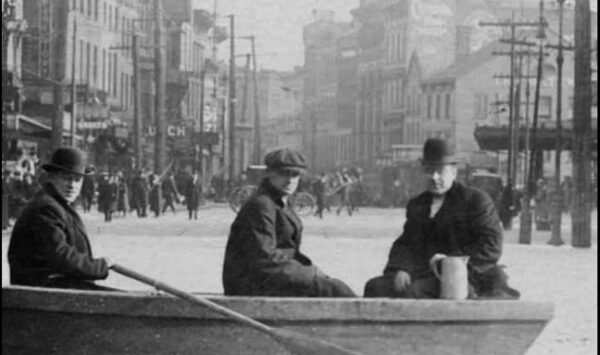
******************************************************************************************************************************** Brownstone Detectives investigates the history of our clients’ homes. The story you are about to read was composed from research conducted in the course of one of those investigations. Do you know the history of YOUR house? ******************************************************************************************************************************** By 7 a.m. on Friday, 9 October 1903, the cellars all along Macon Street were completely inundated with water that was rising quickly toward the basement joists. Without let up, the turgid brown waters continued to pour into the homes through the under-stoop doorways until the floodwaters had reached the level of the basement windowsills, whereupon it then began to pour also through the windows and into the basement dining rooms. The Ocean Hill area, like much of Brooklyn, had fallen victim of the heavy rains that had been falling continuously for much of the night. All the residences along Hancock, McDonough, Macon, Decatur, Bainbridge and Chauncey Streets were so flooded that residents on the ground floor apartments discovered upon waking that they were forced to go to the second floors to escape the waters. “IN SARATOGA PARK…BENCHES WERE FLOATING ABOUT…” The paths in Saratoga Park, according to one newspaper account, “had become running streams and benches were floating about.” The nearby Putnam and Halsey streetcars stopped running, as “it was impossible to take on any passengers, as the water was as high as the seats.” Streets and sidewalks were submerged under several inches of water, and, eventually, furniture moving vans were pressed into service by the police to be used […]
THE DAY RIOTERS STORMED BROOKLYN (1895)
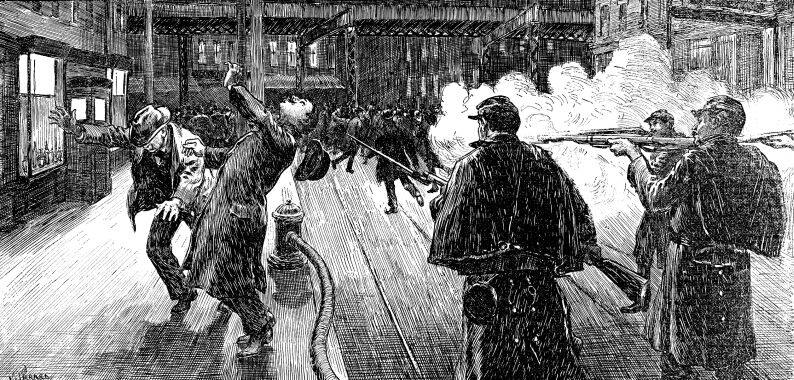
******************************************************************************************************************************** Brownstone Detectives investigates the history of our clients’ homes. The story you are about to read was composed from research conducted in the course of one of those investigations. Do you know the history of YOUR house? ******************************************************************************************************************************** (The above picture shows the New York State militia shooting a man on Halsey Street, near the corner of Broadway. You can see the recently erected elevated train line at the end of the block.) In 1895, Halsey Street near Saratoga Park had become a war zone. The Brooklyn Streetcar strike had begun on 15 January, and before the week was over the agitation would be in full force. The strike, which began with a walkout, would quickly devolve into a pitched battle between the Knights of Labor and streetcar workers on one side and the streetcar line owners, the police and the New York State Militia on the other. The main focus of much of the strikers’ attention in this part of Brooklyn, though, was the Halsey Street Rail Road Barns. These, located near the corner of Halsey Street and Broadway, were where the streetcar line stored its cars, quartered its horses, and from whence the line’s streetcars were dispatched. After the workers had called the strike, 5,500 of them would walk off the job for better conditions. The streetcar line owners (the lines were privately owned and operated at the time) countered this strike by calling in scabs who would attempt to operate the streetcars in the workers’ absence. […]
THE “7-SECOND MAN” OF BED-STUY (1918)
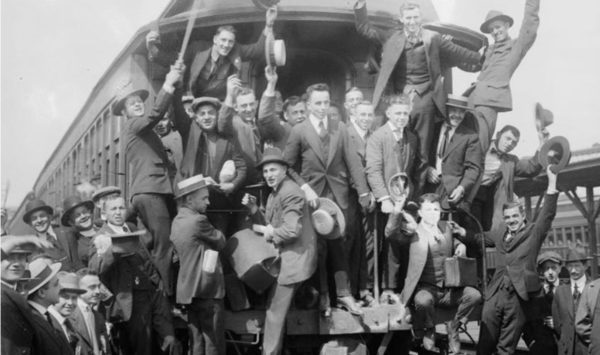
******************************************************************************************************************************** Brownstone Detectives investigates the history of our clients’ homes. The story you are about to read was composed from research conducted in the course of one of those investigations. Do you know the history of YOUR house? ******************************************************************************************************************************** The new “Victory and Peace” war memorial at Saratoga Park, located in the Stuyvesant East section of Brooklyn, was the subject of a public dedication on 10 September 2014. The Brownstone Detectives worked closely with the Parks Department by locating pictures, stories, and relatives of the Stuyvesant Heights men who gave their lives in the Great War. This biography is about one of those men. PRIVATE EDWARD J. BELL In 1920, as the “War to End All Wars” was still fresh on America’s collective conscious, American Legion posts were sprouting up everywhere. The trend existed for two reasons: to support the men who had come back from the front, and to memorialize those who never returned. Many of the posts were named after those who had made the ultimate sacrifice. The Edward J. Bell Post No. 790 had recently been formed to honor Edward Joseph “Eddie” Bell, a 25-year-old machine-gunner, and Purple Heart winner, who died in France on 16 August 1918, from the result of injuries sustained in combat. Born on 6 November 1892, Bell had lived with his father, his aunt and his grandparents at 735 Macon Street. Sometime around 1910, the tall, black-haired, and blue-eyed Bell had graduated from Commercial High School, and soon thereafter lost his father. […]
PVT. EDWIN RUOFF (A BEDSTUY HERO) (1918)
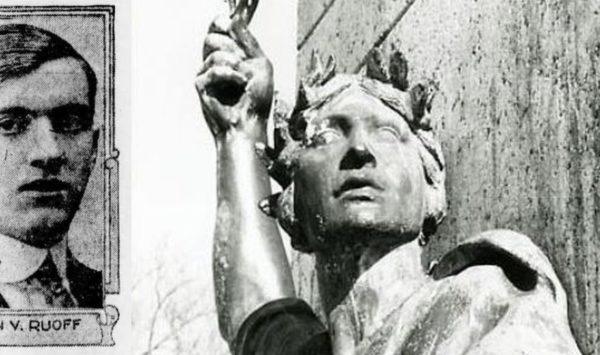
******************************************************************************************************************************** Brownstone Detectives investigates the history of our clients’ homes. The story you are about to read was composed from research conducted in the course of one of those investigations. Do you know the history of YOUR house? ******************************************************************************************************************************** In 2014, The Brownstone Detectives partnered with the New York City Parks Department to help celebrate the lives of the servicemembers of Bedford-Stuyvesant Heights who made the ultimate sacrifice during the Great War. We researched these heroes to locate pictures, stories, and their descendants to be brought together for a ceremony that dedicated a new “Victory and Peace” war memorial at Saratoga Park. This biography tells the story of one of those servicemembers. PVT. EDWIN V. RUOFF Before being drafted into the U.S. Army to fight in the Great War, Private Edwin V. Ruoff was a resident of Stuyvesant Heights where he lived at 193 Ralph Avenue. He was killed in an accidental bomb explosion on 3 June 1918 in France, when a supposedly harmless shell went off. The explosion, which took the lives of 45 soldiers in total, occurred when the company was drilling. It all started when one of the men discovered the “bomb or hand grenade” and “began fooling with it.” Then, “after tossing it about and whirling it around, he let it drop. As the missile hit the ground, there was a terrific explosion, the force of which threw almost every member of the company to the ground.” THE ARMY VISITS MRS. RUOFF According to the Brooklyn […]
CALVIN COOLIDGE & THE BUNNY HUG (1922)

******************************************************************************************************************************** Brownstone Detectives investigates the history of our clients’ homes. The story you are about to read was composed from research conducted in the course of one of those investigations. Do you know the history of YOUR house? ******************************************************************************************************************************** Vice-President Calvin Coolidge came to the Eastern section of Stuyvesant Heights one night late in 1922 to stump for the local Republican senator ahead of the mid-term elections. And in so doing, he would wind up in a nite club known for its bawdy dancing and raids on its illegal booze sales. It was the country’s first “working girl’s model dance hall,” The Arcadia. Dedicated specifically, at the time it was built in 1912, to “proper” dances for working girls, the hall – located at the corner of Halsey Street and Saratoga Avenue, across the street from Saratoga Park – had been supported by proponents who had lobbied successfully for anti-tango legislation, designed to outlaw “the turkey trot and other sensational dances.” For several years, the hall was a chaste facility which forbid “bunny-hugging” and tangoing, and kept a number of dance monitors on the dance floor to enforce these rules. You broke them once and you were kicked out for good – never allowed to return to the popular dance spot. Ten years later, though, it was the era of Prohibition, and the hall’s reputation had sunken somewhat in the estimation of its neighbors. Being the largest dance hall in the area, though, Vice President Calvin Coolidge would use it […]
PVT. BUDD SOMERS (A BEDSTUY HERO) (1918)
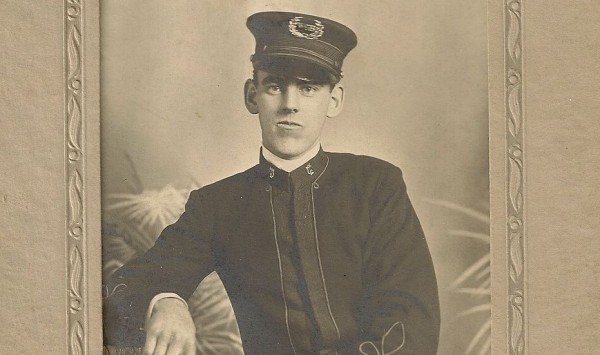
******************************************************************************************************************************** Brownstone Detectives investigates the history of our clients’ homes. The story you are about to read was composed from research conducted in the course of one of those investigations. Do you know the history of YOUR house? ******************************************************************************************************************************** In 2014, The Brownstone Detectives partnered with the New York City Parks Department to help celebrate the lives of the servicemembers of Bedford-Stuyvesant Heights who made the ultimate sacrifice during the Great War. We researched these heroes to locate pictures, stories, and their descendants to be brought together for a ceremony that dedicated a new “Victory and Peace” war memorial at Saratoga Park. This biography tells the story of one of those servicemembers. PVT. BUDD RUSSELL SOMERS “Budd” Russell Somers was born in Owego, New York, near Binghamton, on 3 March 1891. His family moved to Pennsylvania at some point before the century was out. But, Somers would find himself back in Brooklyn sometime after 1910. A “tool maker” at the John Johnson & Company – at 37th Street and 3rd Avenue – Somers was a tall and slender man with grey eyes and chestnut hair. He had been courting Daisy Elizabeth Saxby when American involvement in the Great War became a reality, and so he did what many other young single men going off to war did – he married her. His marriage was the classic pre-war wedding, taking place less than five months before being “called up” in the draft. When that event occurred, on 10 October, Somers boarded […]